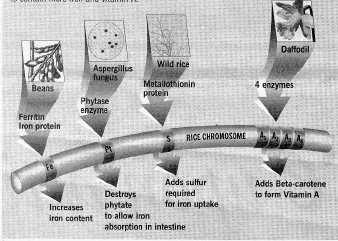The Real Promise of Plant Genetic Engineering
In the last decade the cultivation of genetically modified crops of corn, cotton, and soybeans has become commonplace in the United Statesin 1999, over half of the 72 million acres planted with soybeans in the United States were planted with seeds genetically modified to be herbicide resistant, with the result that less tillage has been needed, and as a consequence soil erosion has been greatly lessened. These benefits, while significant, have been largely confined to farmers, making their cultivation of crops cheaper and more efficient. The food that the public gets is the same, it just costs less to get it to the table.
Like the first act of a play, these developments have served mainly to set the stage for the real action, which is only now beginning to happen. The real promise of plant genetic engineering is to produce genetically-modified plants with desirable traits that directly benefit the consumer.
One recent advance, nutritionally improved rice, gives us a hint of what is to come. In developing countries large numbers of people live on simple diets that are poor sources of vitamins and minerals (what botanists called “micronutrients”). Worldwide, the two major micronutrient deficiencies are iron, which affects 1.4 billion women, 24% of the world population, and vitamin A, affecting 40 million children, 7% of the world population. The deficiencies are especially severe in developing countries where the major staple food is rice. In recent research, Swiss bioengineer Ingo Potrykus and his team at the Institute of Plant Sciences, Zurich, have gone a long way towards solving this problem. Supported by the Rockefeller Foundation and with results to be made free to developing countries, the work is a model of what plant genetic engineering can achieve. To solve the problem of dietary iron deficiency among rice eaters, Potrykus first asked why rice is such a poor source of dietary iron. The problem, and the answer, proved to have three parts:
1. Too little iron. The proteins of rice endosperm have unusually low amounts of iron. To solve this problem, a ferritin gene was transferred into rice from beans (figure 21). Ferritin is a protein with an extraordinarily high iron content, and so greatly increased the iron content of the rice.
2. Inhibition of iron absorption by the intestine. Rice contains an unusually high concentration of a chemical called phytate, which inhibits iron reabsorption in the intestineit stops your body from taking up the iron in the rice. To solve this problem, a gene encoding an enzyme that destroys phytate was transferred into rice from a fungus.
3. Too little sulfur for efficient iron absorption. Sulfur is required for iron uptake, and rice has very little of it. To solve this problem, a gene encoding a particularly sulfur-rich metallothionin protein was transferred into rice from wild rice.
To solve the problem of vitamin A-deficiency, the same approach was taken. First, the problem was identified. It turns out rice only goes part way toward making beta-carotene (provitamin A); there are no enzymes in rice to catalyze the last four steps. To solve the problem, genes encoding these four enzymes were added to rice from a familiar flower, the daffodil.
Potrykus’s development of transgenic rice to combat dietary deficiencies involved no subtle tricks, just straightforward bioengineering and the will to get the job done. The transgenic rice he has developed will directly improve the lives of millions of people. His work is
 Figure 21
Figure 21
Transgenic rice. Developed by Swiss bioengineer Ingo Potrykus, transgenic rice offers the promise of improving the diets of people in rice-consuming developing countries, where iron and vitamin A deficiencies are a serious problem.